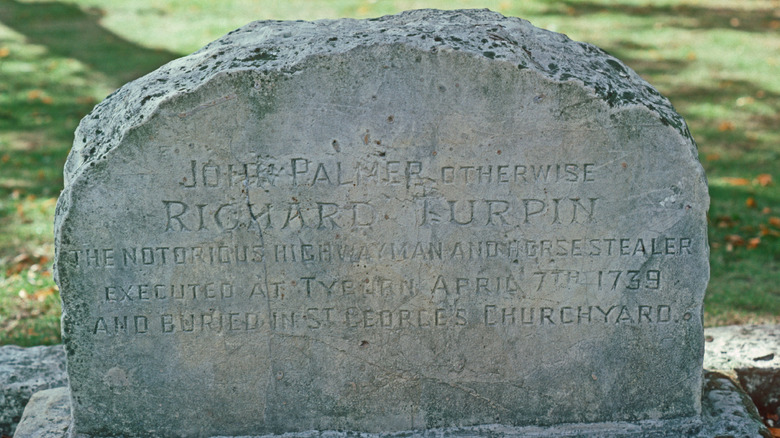Details You Should Know About Legendary Highwayman Dick Turpin
British highwayman Richard "Dick" Turpin roamed the English countryside in the early 1700s, robbing people and stealing horses, until he was executed for the latter in 1739. Per The History Press, thanks to the 1834 novel "Rockwood" by Harrison Ainsworth (and more than a few penny dreadfuls later on), Turpin became a legendary historical figure in the same vein as the United States' Jesse James or Australia's Ned Kelly and has a reputation similar to that of Robin Hood, in terms of robbing from the rich and acting as a dashing gentleman in the midst of carrying out his crimes.
As reported by the London Review of Books, it was in "Rockwood" that Turpin's most famous act of bravery, a midnight ride from London to York in just one night on his trusty mare Black Bess (depicted above), was invented by Ainsworth, and yet the tale was thought of as fact after the book's publication. It inspired the poem "Dick Turpin's Ride" by Albert Noyes, published in 1927, which was later adapted into a 1951 movie of the same title, also known as "The Lady and the Bandit," per the IMDb. However, the ride never happened, and according to Today I Found Out, several of the feats and admirable characteristics attributed to Turpin actually came from other highwaymen, including Swift Nick Nevison, who rarely used violence and was known for being polite to those he robbed. Turpin, on the other hand, was a violent sadist who along with his associates had no qualms about torturing, sexually assaulting, and mutilating their targets, including the elderly and the sick.
Turpin's downfall? Shooting a chicken in the street
According to The History Press and their book "Hanged At York" by Stephen Wade, Dick Turpin was born in 1705. After apprenticing as a butcher, he began stealing and joined the Gregory Gang of Essex, England. His background in butchery made him an asset when it came to stealing cattle. The gang became known for their violence, including pouring boiling water on an old farmer and throwing an elderly woman onto an open fire. His first murder is believed to have been a man named Tom Morris, who recognized him during a robbery. He later joined forces with fellow criminal Tom King, accidentally killing him during a botched robbery. Turpin fled, started going by the alias "John Palmer," and moved northward, where he started stealing horses in earnest.
"John Palmer" was arrested for the bizarre and perplexing crime of shooting a chicken in the street and then threatening to shoot the chicken's owner. In 1737 his former teacher, James Smith, identified him to authorities after recognizing Turpin's handwriting on a letter. Smith was awarded £200 for identifying Turpin; Turpin was sentenced to death by hanging. The only mourners at his funeral were people to whom Turpin had paid ten shillings apiece. Per the London Review of Books, Turpin dressed in fine, formal clothes to go to the gallows and according to a pamphlet that described the execution, "went off this stage with as much intrepidity and unconcern, as if he had been taking horse to go on a journey."

